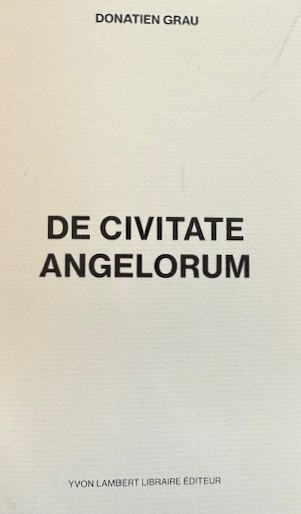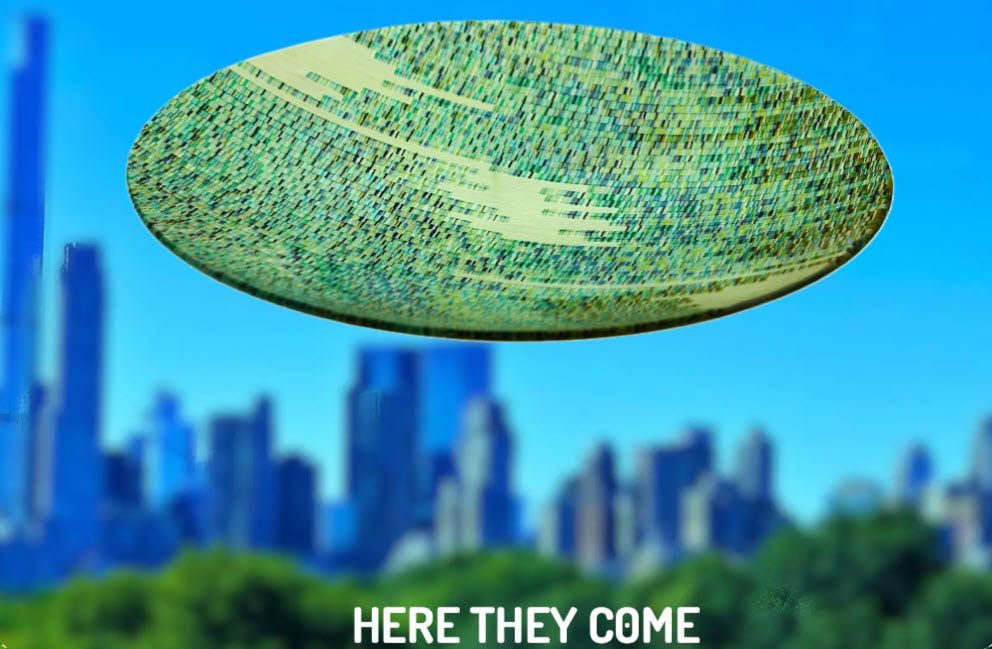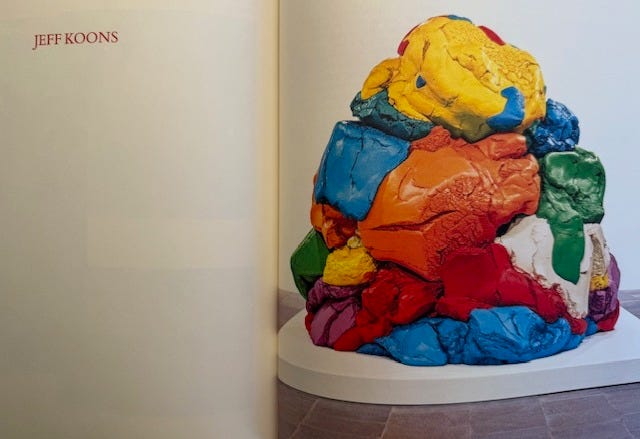Orbis Finiens, translated from Latin, means horizon, or literally, the world ends.1 The two meanings are derivative from Greek, where the word horizon was used to denote boundaries. The other day, the morning had a sunrise that really evoked the sailor’s trope - ‘Red sky in morning, sailors take warning,’ and the view below was down my street and out to the ocean about a few miles from our house and straight East. As I started writing, we had flood watches, deluges of rain and sleet with about 2 or so inches of snow on the ground, with high winds into the evening and late-night - i.e., the storm had arrived, working its way up the coast, bringing precipitation in all of its lovely forms for a December day. So, the picture of the morning sky below could be from California and above Malibu, where the Sana Anna winds rush down the canyons to the sea, bringing fire and destruction. But no, it is here in the East, beauty before the storm.
I have been reading the Oxford Latin Desk Dictionary of late, along with a bunch of other Latin schoolbooks lent to me by my sister-in-law, a former Classics scholar. Why, you may ask, of all things going on in the world and your life, do you spend time trying to understand a dead language? But it is not dead, and while it is not just used in everyday conversation (except maybe in certain places of reverence), it is one of the starting points of our understanding of the world.
And this all started with reading a couple of reviews of Donatien Grau’s “De Civitate Angelorum,” and watching his reading of the tract in a bookstore in NYC via YouTube, a presentation worthy of the intelligentsia, as we used to say at home2, or could it have been a piece of ‘performance art’ with the goal to be kindred to contemporary artists3 To call it a book is a little pretentious, as it is barely 20 pages long, 25 sections with big margins & breaks of white space, in a booklet that is 4-1/2 inches by 7 inches (published May 2023, Latin, Softcover & Stapled, ISBN 978-2-913893-78-8, Yvon Lambert).
I believe that his use of Latin is a method of covering up the ideas in his piece. What also annoyed me was his tourist take on LA. Los Angeles, California, was my home for about 25 years. There is a plethora of literature to digest that could or should warn him about understanding California and Los Angeles (maybe talk to Hockney about it, for one), which is now the hub of the universe of contemporary art.
He should grapple with many writers who have described and analyzed the experience and philosophy of the meaning of this amazing place where culture is king & queen, with abundant sunshine and a menacing vibe. Writers such as Joan Didion - Slouching Towards Bethlehem, the White Album;4 or Mike Davis, City of Quartz: Excavating the Future in Los Angeles; or Kevin Star’s series on California, the last one (#7) - Golden Dreams: California in an Age of Abundance, 1950-1963, where he discusses the rise of LA as a super city, eclipsing New York as the cultural capital of the US and other megacities of the world. That is, if he wants to make his mark in LA - applying a light coat of opaque language to a very complex place with a long history of it’s own that has shaped what it is today.
I have put the book through a translator, and it is a very amusing version of a translation of the ‘See Dick Run’ variety of my kindergarten years. I have have put the first chapter of his essay below, with some attempt to clean up the AI and put it out there as it would seem to convey one of the very same points as the medium that he chose. That is, layering Latin, which only a few people give a damn about these days, onto Los Angeles, where his pithy observations are not only repetitive of many other authors and not elegant or unusual in the least, was a mistake hidden by being opaque in both his intent and method.
But no, we have a text, a few readings in Latin, some reviews, and, again, a Twitter approach to a subject that many others have dealt with in depth. But how do you know what the Latin could be saying, as no one has done a translation? Artificial Intelligence (AI) + JDK attempt to translate and voila, you have a version below for your consideration, and grammar be damned! However, Latin grammar is the key to understanding the ‘true’ meaning of the writing. So this is my weak attempt to make some sense of the first chapter (but calling a paragraph a chapter is a little presumptuous, don’t you think?
- Latin Scholars Beware -
1
In ultima terra Civitas Angelorum locata est. Nam inter solitudines et mare, montes et caelum, silvas et urbem, posita est. Civitas Angelorum omnis est divisa in partes decem, quae nominibus memoriam sanctorum hominum et sanctarum mulierum celebrant. Altera quaeque pars ab hortis aut a silvis nominata est. Partes linguis, institutis, legibus inter se differunt. Quaedam partes pauperes, quaedam divitissimae. Quaedam frequentissirnae, quaedarn desertae. Quaedarn magnis aedificiis ornantur, quaedarn dernissis domibus. Diversitas est surnrna in ilia civitate in fine rnundi.
In the farthest land, the City of Angels is situated. It is located between the deserts and the sea, the mountains and the sky, the forests and the city. The City of Angels is divided into ten parts, whose names celebrate the memory of holy men and women. Each other part is named after a garden or forest. The residents differ from each other in language, institutions, and morals. Some sections are poor, some very rich. Some are crowded, and some are desert. Some sections have great buildings of unusual décor; some buildings do not put their weight upon the ground. There is, great diversity in that city at the end of the world. [AI+JDK]
My paltry attempts leave something to be desired or the content is put into lacunae of understanding with intentionality. So, I need to do more work - a down-the-rabbit-hole exercise to understand what Grau was attempting to communicate and what I thought about it in all its delivery mediums (because artists work in a variety of mediums)5 to communicate their vision, also known as the ‘mind's eye.’ And as to whether language is the mind’s eye or the filter for all of our senses and understanding of the world, it is a conundrum not to be trifled within a short essay. Reading his various works - Plato in LA and Under Discussion: The Encyclopedic Museum,6 has assisted me in this effort, and upon reflection, I am not so dismissive of the attempt to capture a piece of the LA story with a Latin tourist view. But it seems just too Western and elitist in this age for little old me.
He might (I learned my lesson about telling anyone else that they ‘should’ do something without considering who they see as an Old White Privileged Male) think about being more inclusive of the considerable impact of the LA way of being in its space. For example, see Balance, the whole World Wall: A Vision of the Future Without Fear, 1990 below—Judith F. Baca, which reclaims history by adding the marginalized and maligned.
The story of LA and California is definitely not imperial (while there have been attempts, it has always been at the edge of the various empires that come & go). LA is a place of popularitas (that is, the courting of popular favor) and experimentum pericululum (that is, risky experiments). From food to art, there is always something to see and do (& not as expensive and without the NYC attitude).
Los Angeles is a never-ending kaleidoscope of people, music, film, performances of all stripes, ethnic groups (where Anglos are a minority), food, freeways, neighborhoods, cars, art, and art museums, architecture that can be ridiculous, different, and awesome, large sculptures and murals, writers, weather (yes, snow to desert), hiking trails, silence, water, sun, sky, and all the horizons that you could imagine.
My Latin sucks, and as my mother and father are both dead, so they can’t help me now. Mom spoke and read Latin, and my Dad’s dissertation was on the history of ideas.7 Both were of the intelligentsia of the time but not of the WASP non-Marxist male-dominated elite and thus were marginalized and diminished by many people of the time. At least, that is my memory of their recounting of the times of their youth before I came along (you know, I have to work to get my leftist/progressive & Latin bona fides into the dialogue).
And, (I also learned that ‘BUT’ is now verboten because it is a trigger); as a sociologist-cum-artist, I can recognize the patterns of a student’s (as I still a student, too) attempts to learn from the experts and experiment are within a medium they are present in Grau’s works. As a footnote to this paragraph, I want to laud his use of interviews (a tool from social science), which lets artists and others respond in a conversational and understandable tone to his extremely good questions in these works, but the mosaic or vision, or message has not been delivered to the audience I believe. But I will say yet, too, because he is young and has more time to deliver.
BTW one of the nice things about being an artist and sociologist at the same time is the overlap of languages used to talk about the profession; for example, artists talk about the tools or medium of the work (e.g., sculpture, collage, painting, watercolor, kiln formed glass, etc.), while sociologists talk methods or tools for research (e.g., participant observation, surveys, record abstraction, etc.).
But enough of this abstract and going nowhere discussion. Time to move this train along…
I have my first exhibition of my work! This was not an easy step; most artists do everything themselves. This is part of the appeal to me—as a perfectionist, or one could say, I have just enough desire for perfection to produce good work. I am exhibiting at the Falmouth Artists Showcase at the Library here in Falmouth (5 Lunt Road) from December 6, 2024, to February 28, 2025. I am showing a 22-inch diameter glass bowl, Genomic Crash. On my new display stand (24” X 24” square and 38” high), I designed it to under-light the bowl. It breaks apart for easy moving, and each section is light enough for an old man to pick it up and carry it; see below. Hopefully, the plexiglass dome will arrive soon to protect it from the curious who like to touch things (I am one of them; I love picking up glass objects).
I also made a postcard of the work for marketing and dissemination. Please see the next picture below as well. I use a Tens Years After’s tune title as a caption for the bowl superimposed on a photograph of mine of the NYC skyline/horizon. It gives you a very different vibe, eh?
Happy New Year to you all, and I hope you and your family have health, happiness, and laughter throughout 2025
Cheers
Joel
The term "Orbis finials" combines two Latin words: Orbis: Meaning "circle," "orb," or "world," and Finiens: The present active participle of the verb "fine," meaning "to finish," "to limit," or "to set bounds to”. When combined, "orbis finiens" literally translates to "the world ends" or "the ending world," poetically capturing the concept of the horizon as the apparent line where the Earth and sky meet. LATIN PHRASE-BOOK, by C. Meissner translated from the Sixth German Edition, with the addition of supplementary phrases and references by H.W. Auden, MA, Assistant Master at Fettes College, Edinburgh,; Late Scholar of Christ’s College, Cambridge, and Bell University Scholar, London, Macmillan and Co., New York, 1894.
According to Marx, the intelligentsia is a social class of university-educated people who use their mental labor to lead, shape, and critique their society's politics, culture, and policies. The word "intelligentsia" came from a Latin word meaning intelligence and entered the modern global vocabulary from Russia. While Emma Goldman is likely the pinnacle of the intelligentsia, and Grau has some climbing to do, maybe in the age of TikTok, doing a performative event without a clue (nor the listeners) about the place that one is speaking of is all you have to do now.
After all, Grau is the head of Contemporary Programmes at the Louvre, the world’s biggest museum, so both gravitas and being one of the Avant-garde are de rigueur!
She is the Dean of California writing and style, and iconic is an understatement of her impact on much of the contemporary world as we now see it in our mind’s eye.
In its most general sense, a medium is a means of transmitting some matter or content from a source to a reception site. The function of a medium, so construed, is mediation. Natural media such as air and water mediate the transmission of sounds. An art medium, then, is something that mediates the transmission of the content of an artwork to a receiver. Art media, so conceived, have been characterized in several different ways: as material or physical kinds (e.g. oil paint, bronze, stone, bodily movements); as ranges of sensible determinables realizable in material or physical kinds (e.g. pitch, tone, texture, colour); as ways of purposively realizing specific values of such determinables (e.g. brushstrokes, gestures), or as systems of signs (‘languages’ in a more or less strict sense). Oxford Handbook of Asethetics. https://doi.org/10.1093/oxfordhb/9780199279456.003.0009
He was busy while lounging around the pools in LA and his stay at the Getty -Donatien Grau, Plato in LA, Contemporary Artist’s Visions, The J. Paul Getty Museum, Los Angeles, 2018; Under Discussion, The Encyclopedic Museum, D. Grau, ed., Getty Research Institute, Los Angeles, 2021.
AND Koon’s PLAY-DOH and interview (among the others) is a lot of fun.
Martin Kallich, The association of ideas and critical theory in eighteenth-century England: A history of a psychological method in English criticism, Mouton, The Hague, 1970.










